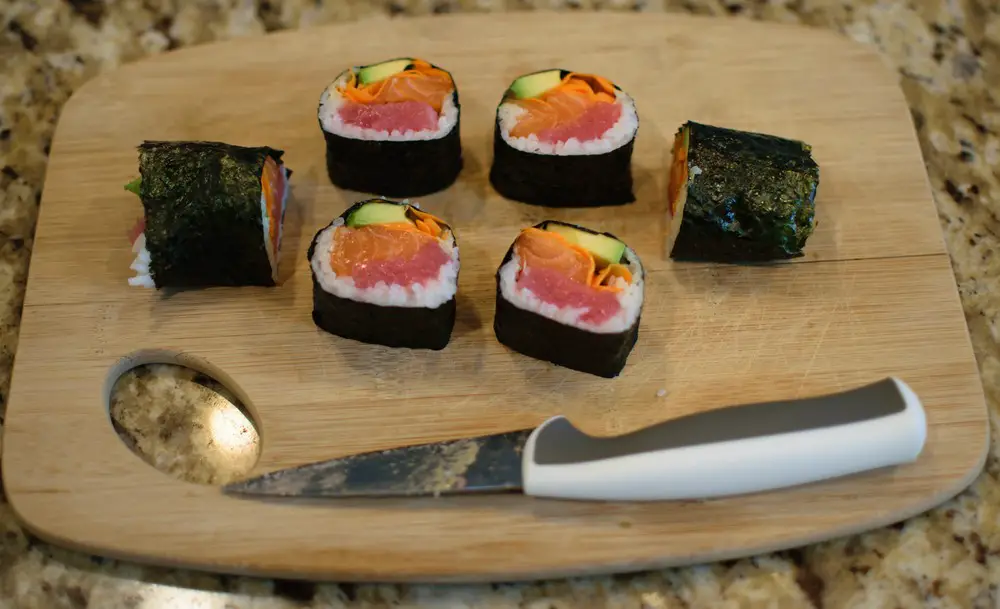Sushi is a traditional Japanese dish that has become incredibly popular worldwide. While making sushi involves various skills and techniques, having the right tools is also crucial. One of the most important tools for making sushi is the knife.
Sushi knives, also known as sushi-bōchō or sashimi knives, are crucial for any sushi chef. These knives are specifically designed for slicing raw fish and other seafood into precise, thin slices essential to sushi and sashimi dishes.
However, choosing the right sushi knife can be overwhelming, especially for those new to sushi making. In this guide, we’ll break down the different types of sushi knives, their features, and how to choose the right one for your needs.
Types of Sushi Knives:
Several types of sushi knives are available, each with its unique shape and function. Here are the most common types of sushi knives:
1. Yanagiba Knife
The Yanagiba knife, also known as a Sashimi knife, is the most commonly used knife for slicing fish for sushi. Its long, slender blade is perfect for making clean, precise cuts, and its sharp point allows easy skin separation from the flesh. The blade length can range from 8 to 12 inches, with the longer blades used for larger fish.
2. Takohiki Knife
The Takohiki knife is similar to the Yanagiba knife but has a rectangular blade instead of a pointed one. This knife is typically used for slicing octopus and squid, which are more challenging to cut due to their tougher texture. The blade length of a Takohiki knife is usually around 10 to 12 inches.
3. Deba Knife
The Deba knife is a heavy-duty knife used for filleting fish, cutting through bones, and preparing other meat. Its thick, durable blade can handle the toughest of ingredients and can be used to cut through the heads and tails of fish. Deba knives are available in blade lengths ranging from 6 to 9 inches.
4. Usuba Knife
The Usuba knife, also known as the vegetable knife, is designed for cutting vegetables and fruit used in sushi. Its flat blade allows for a straight cutting motion, making it easier to create precise cuts. Usuba knives are available in blade lengths ranging from 6 to 10 inches.
5. Nakiri Knife
The Nakiri knife is similar to the Usuba knife and is also used for cutting vegetables. However, its blade has a slight curve, making it easier to rock back and forth when chopping. Nakiri knives are available in blade lengths ranging from 6 to 7 inches.
6. Fugu Hiki Knife
The Fugu Hiki knife is a specialized knife used to prepare fugu, a poisonous pufferfish considered a delicacy in Japan. The Fugu Hiki knife has a unique design that allows it to cut the fish in a way that avoids the poisonous parts while maximizing the amount of meat that can be used. This knife is not recommended for novice sushi chefs.
Features of Sushi Knives:
When choosing a sushi knife, there are several features to consider. Here are the most important features to keep in mind:
- Blade Material: Sushi knives are typically made from high-carbon stainless or traditional carbon steel. High-carbon stainless steel is more durable and rust-resistant, while traditional carbon steel is easier to sharpen and provides a sharper edge.
- Blade Length: Sushi knives typically range from 7 to 12 inches. The length of the blade you choose will depend on your preference and the type of sushi you’ll make.
- Blade Thickness: The thickness of the blade will affect the weight and balance of the knife. Thicker blades are more durable, while thinner blades provide a more precise cut.
- Handle Material: Sushi knife handles are typically made from wood or plastic. Wood handles are more traditional and provide a better grip, while plastic handles are easier to clean and sanitize.
How to Choose the Right Sushi Knife?
Choosing the right sushi knife will depend on several factors, including your skill level, the type of sushi you’ll make, and your preferences. Here are some tips to help you choose the right sushi knife:
- Consider your skill level: If you’re new to sushi making, a yanagiba or takohiki may be too challenging. A deba or usuba knife may be a better choice for beginners.
- Think about the type of sushi you’ll be making: If you’ll be making a lot of sashimi dishes, a yanagiba or takohiki knife is a must-have. If you prepare more vegetables, an usuba knife may be a better choice.
- Consider your budget: Sushi knives can range in price from less than $50 to several hundred dollars. Decide how much you’re willing to spend before you start shopping.
- Test the knife before you buy: If possible, try holding and testing the knife before purchasing. This will give you a better idea of how the knife feels in your hand and whether it’s the right choice for you.
Final Words:
In conclusion, having the right sushi knife is essential for creating delicious and visually appealing sushi. Each knife is designed for a specific purpose, and having a variety of knives on hand can make the sushi-making process much easier. Whether you’re a professional sushi chef or a home cook, investing in a quality set of sushi knives is well worth it.

